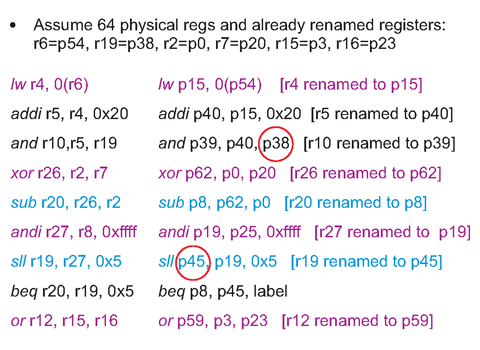| |
Register renaming
- Registers visible to the compiler
- Logical or architectural registers
- Normally 32 in number for RISC and is fixed by the ISA
- Physical registers inside the processor
- The destination logical register of every instruction is renamed to a physical register number
- The dependencies are tracked based on physical registers
- MIPS R10000 has 32 logical and 64 physical regs
- Intel Pentium 4 has 8 logical and 128 physical regs


- Now it is safe to issue them in parallel: they are really independent (compiler introduced WAW)
- Register renaming maintains a map table that records logical register to physical register map
- After an instruction is decoded, its logical register numbers are available
- The renamer looks up the map table to find mapping for the logical source regs of this instruction, assigns a free physical register to the destination logical reg, and records the new mapping
- If the renamer runs out of physical registers, the pipeline stalls until at least one register is available
- When do you free a physical register?
- Suppose a physical register P is mapped to a logical register L which is the destination of instruction I
- It is safe to free P only when the next producer of L retires (Why not earlier?)
- More physical registers
- more in-flight instructions
- possibility of more parallelism
- But cannot make the register file very big
- Takes time to access
- Burns power
|
| |
| |
| |
| |
| |
| |
| |
| |
| |
| |
| |
| |
| |
| |
|
|
|
|